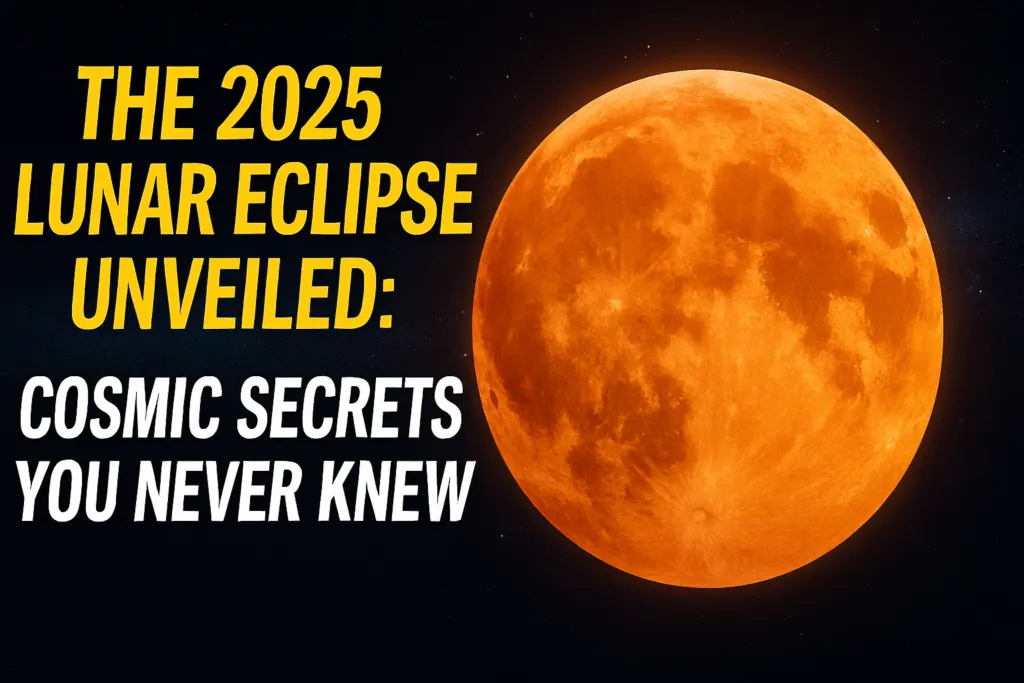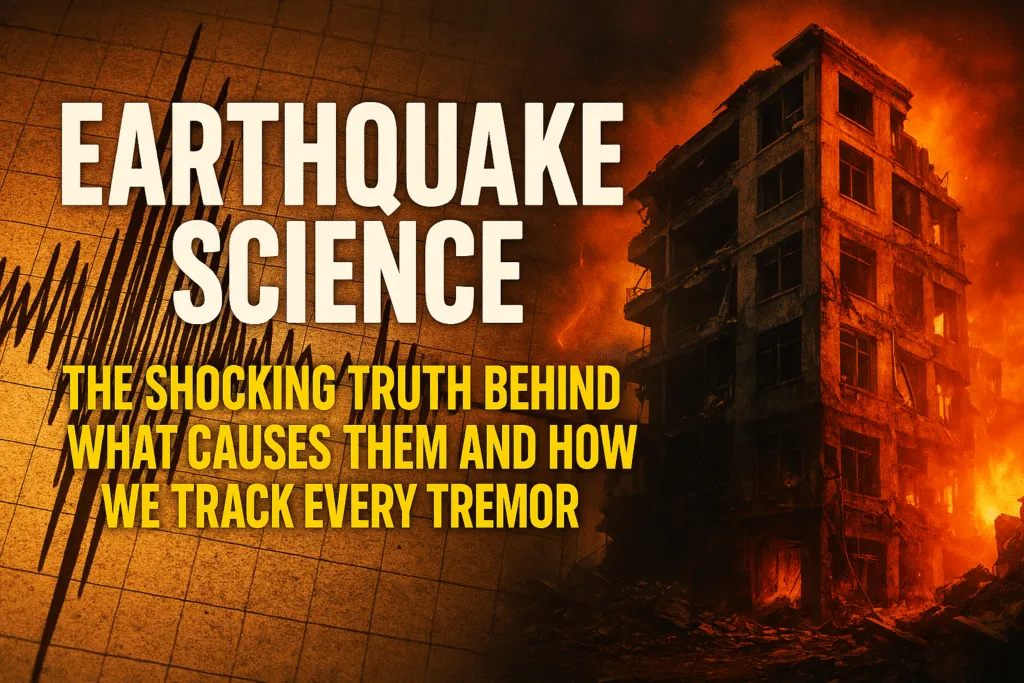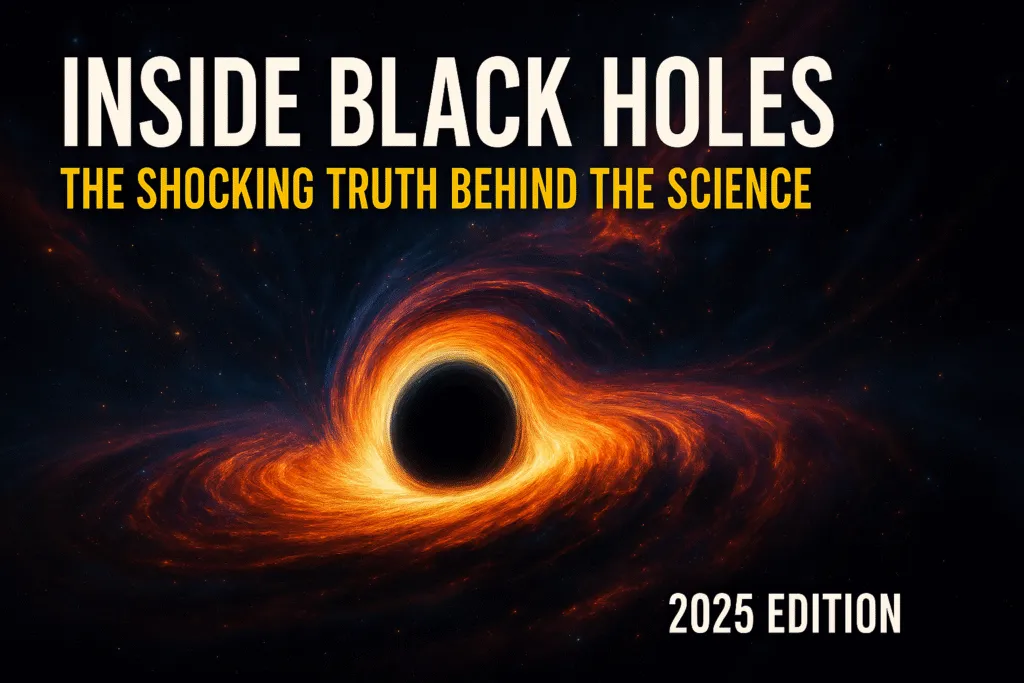Introduction: Why the 2025 Lunar Eclipse Matters
The 2025 Lunar Eclipse is more than just an astronomical event; it is a moment where science, nature, and human curiosity come together under the same night sky. For centuries, people have looked up at lunar eclipses with awe, weaving myths, spiritual meanings, and scientific theories around them. But in today’s world, this event carries a deeper significance. It is not only a chance to witness a stunning visual spectacle but also an opportunity to understand the fascinating mechanics of our universe.
What makes the 2025 Lunar Eclipse so important is the way it bridges the gap between everyday stargazing and complex cosmic science. As the Earth casts its shadow over the Moon, viewers get to see a real-time demonstration of planetary motion. Unlike many space phenomena that require powerful telescopes, a lunar eclipse is accessible to everyone with clear skies. This makes it a rare astronomical event that unites people globally, from casual skywatchers to seasoned astronomers.
The upcoming eclipse also matters because it offers insights into Earth’s atmosphere. The reddish glow that often covers the Moon during the eclipse, popularly called a “blood moon,” is caused by the scattering of sunlight through Earth’s atmosphere. Studying this light helps scientists better understand environmental changes and atmospheric composition. For tech enthusiasts and bloggers, the event is also a great opportunity to capture high-resolution images, experiment with astrophotography gear, and share real-time observations with the world.
Ultimately, the 2025 Lunar Eclipse is more than a date on the calendar. It is a reminder of how small yet significant our place is in the cosmic order. Whether you are watching for scientific knowledge, cultural interest, or simply for the beauty of the night sky, this lunar event promises to be unforgettable.
What is a Lunar Eclipse? A Quick Refresher
A lunar eclipse is one of the most fascinating celestial events, where the Earth, Sun, and Moon align in a straight line. During this alignment, the Earth comes directly between the Sun and the Moon, casting its shadow on the lunar surface. Unlike a solar eclipse, which can only be viewed from specific regions, a lunar eclipse is visible from anywhere on Earth where the Moon is above the horizon. This makes it a truly global event that draws millions of skywatchers.
There are three main types of lunar eclipses: total, partial, and penumbral. In a total lunar eclipse, the Moon passes completely into Earth’s shadow, often taking on a reddish or copper hue, a phenomenon known as the “blood moon.” A partial eclipse happens when only a part of the Moon enters the darkest part of Earth’s shadow, creating a striking contrast of light and darkness. Meanwhile, a penumbral eclipse is the most subtle form, where the Moon only passes through the lighter shadow of Earth, causing a gentle dimming that can be difficult to notice with the naked eye.
What makes a lunar eclipse so captivating is that it requires no special equipment to observe. While telescopes and binoculars can enhance the view, even casual observers can experience the full beauty of the event by simply looking up at the sky. For scientists, each lunar eclipse provides valuable data about Earth’s atmosphere, as the sunlight bending around the planet gives the Moon its reddish glow.
In simple terms, a lunar eclipse is nature’s way of showing us the delicate balance and alignment of our solar system. It is both a scientific phenomenon and a visual spectacle, offering a rare chance to witness the cosmic dance of Earth, Moon, and Sun in perfect harmony.
Types of Lunar Eclipses and Where 2025 Fits In
A lunar eclipse may seem like a single event, but it actually comes in three distinct types, each with its own unique beauty. Understanding these variations makes the 2025 Lunar Eclipse even more fascinating, as it falls into a category that promises a breathtaking view.
The first type is the penumbral lunar eclipse, which occurs when the Moon passes through the outer shadow of Earth, known as the penumbra. This type is the hardest to detect with the naked eye, as the Moon only dims slightly without any dramatic color changes. While subtle, it still offers a quiet reminder of the cosmic alignment above us.
The second type is the partial lunar eclipse, where only a portion of the Moon moves into Earth’s darker shadow, or umbra. This creates a striking contrast between the shadowed section and the bright, illuminated part. Partial eclipses are easier to observe and often leave viewers amazed at how clearly Earth’s shadow can be seen cutting across the lunar surface.
The most dramatic and widely celebrated is the total lunar eclipse. Here, the entire Moon enters Earth’s umbra, resulting in a breathtaking transformation. Instead of disappearing completely, the Moon often glows in shades of red or copper, earning it the popular nickname “blood moon.” This phenomenon happens because Earth’s atmosphere bends sunlight, scattering shorter wavelengths and allowing red hues to reach the Moon.
So where does the 2025 Lunar Eclipse fit in? The upcoming event is a total lunar eclipse, meaning the Moon will be fully engulfed in Earth’s shadow, glowing with that iconic reddish tint. This makes it one of the most anticipated celestial events of the year, visible to millions across different continents. For skywatchers, it’s a perfect opportunity to witness the rarest and most awe-inspiring type of lunar eclipse.
The Date, Time, and Visibility of the 2025 Lunar Eclipse
The 2025 Lunar Eclipse is set to be one of the most spectacular sky events of the year, and knowing when and where to watch it will help you prepare in advance. This total lunar eclipse will take place on March 14, 2025, when the Moon will move completely into Earth’s shadow, creating the mesmerizing reddish glow often called a “blood moon.” For astronomy lovers and casual skywatchers alike, this date should be marked on the calendar.
In terms of timing, the lunar eclipse will unfold in several phases, starting with the penumbral stage, followed by the partial eclipse, and finally the total phase where the Moon will be fully covered. Depending on your location, the totality is expected to last for more than an hour, offering plenty of time to enjoy the view and capture photographs. The exact timing will vary slightly across regions, but the event will occur during the night hours, making it accessible without any special arrangements.
When it comes to visibility, the 2025 Lunar Eclipse will be observable across large parts of the globe. Regions of Asia, Africa, Europe, and Australia will have the best view of the entire eclipse, while parts of North and South America will be able to witness it during the early or late stages. Since lunar eclipses are safe to watch with the naked eye, you won’t need any protective glasses like those required for solar eclipses.
This widespread visibility makes the 2025 Lunar Eclipse a truly global event. Whether you plan to enjoy it from your backyard, a rooftop, or through a telescope, the sight of the Moon turning into a glowing red orb will be unforgettable. For many, this eclipse will not just be a celestial spectacle, but also a chance to connect with the universe in a deeply personal way.
Scientific Insights: What Makes This Eclipse Unique
The 2025 Lunar Eclipse is not just another celestial show; it holds unique scientific significance that sets it apart from previous eclipses. Unlike ordinary full moons, a lunar eclipse gives scientists a natural laboratory to study the Earth, its atmosphere, and even the Moon’s surface under different conditions. What makes this particular event so exciting is the combination of timing, duration, and atmospheric effects.
One of the most unique aspects of the 2025 Lunar Eclipse is its long totality phase. The Moon will remain fully immersed in Earth’s shadow for over an hour, giving researchers more time to collect valuable data. This extended period allows astronomers to observe the way Earth’s atmosphere filters sunlight and bends it onto the lunar surface, creating the famous reddish glow. By analyzing the color intensity and variations, scientists can learn about dust particles, pollution levels, and even the impact of volcanic eruptions on Earth’s atmosphere.
Another key insight is how lunar eclipses act as a cosmic mirror of Earth’s environment. When sunlight passes through Earth’s atmosphere and reaches the Moon, it carries information about the gases present in our air. By studying this refracted light, researchers can refine climate models and improve their understanding of atmospheric changes. In fact, some studies suggest that lunar eclipses could even help in the search for habitable planets by teaching us how to detect atmospheric signatures from afar.
For tech enthusiasts and astrophotographers, the uniqueness lies in the opportunity to capture high-resolution images that reveal subtle details of the lunar surface under unusual lighting. The Moon’s features appear sharper during the reddish phase, providing a chance to study craters and textures in ways that are not visible during regular full moons.
The 2025 Lunar Eclipse, therefore, is more than just a spectacle—it is a rare scientific window into both our planet and the wider cosmos.
Cosmic Secrets: Rare Phenomena to Watch in 2025
The 2025 Lunar Eclipse is not just a stunning red moon in the night sky; it also comes with a series of rare cosmic secrets that make this event extraordinary. Every lunar eclipse has something unique to offer, but the one in 2025 is expected to showcase unusual celestial alignments and visual effects that skywatchers should not miss.
One of the most anticipated phenomena is the deep red hue of the Moon, often called the “blood moon.” While this is common during a total lunar eclipse, the intensity of the red glow in 2025 is predicted to be particularly striking due to atmospheric conditions. The scattering of sunlight through Earth’s atmosphere will create a brilliant coppery tone, making the Moon appear otherworldly.
Another rare feature is the alignment with bright stars and planets. During the eclipse, viewers in certain regions will see the Moon positioned close to constellations and possibly near bright planets like Saturn or Jupiter. This adds a cosmic backdrop that enhances the beauty of the event and makes it perfect for astrophotography.
The 2025 Lunar Eclipse also offers a chance to observe subtle changes in brightness across different phases. As the Moon moves deeper into Earth’s shadow, careful observers will notice gradients of color, from pale orange to deep crimson. These shades reveal information about Earth’s atmospheric clarity and can even hint at recent volcanic activity worldwide.
For those passionate about mythology and astrology, this eclipse carries symbolic weight as well. Ancient cultures often linked lunar eclipses with transformation, renewal, and cosmic balance. While science explains the mechanics, the cultural stories surrounding the event add another layer of fascination.
In short, the 2025 Lunar Eclipse is not only a natural wonder but also a cosmic stage where rare and beautiful phenomena come together, offering a once-in-a-lifetime experience for skywatchers worldwide.
Myths and Beliefs About Lunar Eclipses Across Cultures
Throughout history, the lunar eclipse has been more than just a natural event. For many cultures, it carried deep symbolic meaning, inspiring myths, legends, and spiritual beliefs. The 2025 Lunar Eclipse, while explained by science, still connects us to these ancient stories that reveal how humanity has always tried to interpret the mysteries of the sky.
In ancient India, a lunar eclipse was often explained through mythology. It was believed that the demon Rahu swallowed the Moon, causing it to disappear into darkness. Rituals and prayers were performed during the eclipse to ward off negative energy and bring balance back to the cosmos. Even today, many households follow traditional practices like fasting or avoiding certain activities during the eclipse.
The Chinese culture also had fascinating beliefs. They saw the lunar eclipse as a celestial dragon trying to devour the Moon. To protect it, people would beat drums and create loud noises, believing this would scare the dragon away. This cultural tradition highlighted how communities used unity and rituals to feel in control of cosmic events.
In ancient Mesopotamia, lunar eclipses were seen as omens for kings and rulers. Priests carefully observed them to predict the future or prepare for significant events. Similarly, in Mayan civilization, eclipses were considered powerful signs from the gods, often associated with cycles of destruction and renewal.
In more modern interpretations, some cultures view the lunar eclipse as a period of transformation or new beginnings. Astrologers often connect it with emotional release, spiritual growth, and personal change.
While today we understand the scientific cause of a lunar eclipse, these myths remind us of the human need to connect cosmic phenomena with meaning. The 2025 Lunar Eclipse, therefore, is not only a celestial event but also a bridge linking ancient wisdom with modern knowledge.
Astrological Significance: What It Means for Zodiac Signs
While science explains the mechanics of a lunar eclipse, astrology adds another layer of meaning by connecting the event to human emotions, energy shifts, and personal growth. The 2025 Lunar Eclipse is considered especially powerful in astrology because eclipses often mark turning points, endings, and new beginnings. For many zodiac signs, this celestial event will bring moments of reflection, transformation, and opportunities for change.
For fire signs (Aries, Leo, Sagittarius), the eclipse energy could inspire bold decisions and a desire to move forward with long-delayed goals. It may feel like a cosmic push to step out of comfort zones and embrace leadership or creative ventures.
For earth signs (Taurus, Virgo, Capricorn), the lunar eclipse may highlight practical matters, such as finances, stability, or career growth. These signs could feel a stronger need to ground themselves and focus on long-term security, while also letting go of outdated habits that no longer serve them.
For air signs (Gemini, Libra, Aquarius), the eclipse energy is likely to affect relationships, communication, and social connections. There could be important conversations or revelations that bring clarity, helping these signs build more balanced and meaningful bonds.
For water signs (Cancer, Scorpio, Pisces), the lunar eclipse may open the door to deep emotional healing. Feelings buried in the past could surface, offering an opportunity to release negativity and embrace personal transformation. This makes it a period of spiritual renewal and inner strength.
Astrologers often describe lunar eclipses as cosmic resets, moments when the universe encourages growth by pushing us to face what we’ve ignored. Whether you believe in astrology or not, the 2025 Lunar Eclipse offers a chance to pause, reflect, and realign your path with your true purpose.
How to Safely Watch the 2025 Lunar Eclipse
One of the most exciting things about a lunar eclipse is that it is completely safe to watch with the naked eye. Unlike a solar eclipse, which requires special glasses or filters to avoid eye damage, the 2025 Lunar Eclipse can be enjoyed without any protective gear. This makes it one of the most accessible astronomical events for people of all ages.
To get the best experience, the first step is to check the timing and visibility of the eclipse in your region. Since the event will be visible across Asia, Africa, Europe, and parts of the Americas, knowing the exact local time will help you plan ahead. Setting reminders a few days earlier ensures you won’t miss the spectacular total phase when the Moon turns deep red.
Finding the right viewing spot also makes a big difference. Choose a location with a clear, unobstructed view of the sky, away from city lights and pollution. Rural areas, rooftops, or open fields provide the best visibility. If possible, bring a blanket or reclining chair to comfortably enjoy the event for its full duration.
While no special equipment is necessary, using binoculars or a telescope can enhance the experience by revealing details of the lunar surface during the eclipse. Amateur photographers can also capture stunning images by using a tripod and adjusting camera settings for low-light conditions.
Another important tip is to prepare for the weather. Since cloud cover can block visibility, keep an eye on local forecasts and consider traveling to a nearby clear-sky location if needed.
Ultimately, the 2025 Lunar Eclipse is a chance to connect with the universe in a safe, memorable way. Whether you watch it with family, friends, or alone, the event promises a breathtaking display that requires nothing more than looking up at the night sky.
Tips for Photographing the Eclipse Like a Pro
The 2025 Lunar Eclipse is not only a spectacular event to witness but also a golden opportunity for photographers to capture breathtaking images of the night sky. Unlike fast-moving meteors or distant galaxies, a lunar eclipse unfolds slowly, giving plenty of time to plan and experiment with shots. With the right techniques, even beginners can photograph the eclipse like a pro.
The first step is to choose the right equipment. While a DSLR or mirrorless camera offers the best results, even a modern smartphone with a good camera can capture striking images when paired with a tripod. A telephoto lens (200mm or longer) is ideal for bringing the Moon’s surface details into focus, while wide-angle shots can beautifully frame the eclipse against landscapes, buildings, or starry skies.
Next, pay attention to camera settings. Since lighting changes throughout the eclipse, you’ll need to adjust exposure as the Moon darkens and turns red. Start with a low ISO (100–400) for sharp images, use a slower shutter speed (1–4 seconds) during totality, and keep the aperture wide (f/4–f/8). Always shoot in RAW format if possible, as it allows more flexibility in post-processing.
A sturdy tripod is essential to avoid blurry images caused by camera shake. Pairing it with a remote shutter release or using the camera’s timer function will further reduce vibration. For smartphones, use night mode or manual settings if available, and stabilize your device with a phone mount.
Don’t forget the creative side of astrophotography. Experiment with different compositions, such as framing the Moon with trees, city skylines, or water reflections. Capturing the progression of the eclipse in a time-lapse sequence can also create a stunning final result.
With preparation, patience, and creativity, the 2025 Lunar Eclipse can become more than just a memory—it can be a collection of professional-quality photographs to treasure and share.
The Bigger Picture: How Eclipses Help Us Understand the Universe
The 2025 Lunar Eclipse is not just a moment of beauty in the night sky; it also plays a vital role in deepening our understanding of the universe. Throughout history, eclipses have helped scientists unlock some of the greatest mysteries of astronomy, from proving Earth’s round shape to refining our knowledge of planetary motion. Even today, a lunar eclipse serves as a natural experiment that reveals valuable insights about both our planet and the cosmos.
One of the biggest contributions of a lunar eclipse is the way it demonstrates planetary alignment and orbital mechanics. Watching Earth’s shadow move across the Moon provides visible proof of how celestial bodies interact in space. This simple yet powerful event reminds us of the precision with which the solar system operates.
Lunar eclipses also act as windows into Earth’s atmosphere. The reddish glow we see on the Moon during totality occurs because sunlight bends through our atmosphere before reaching the lunar surface. By studying the color and intensity of this glow, scientists can measure the presence of dust, pollution, or even volcanic ash. In this way, a lunar eclipse becomes a tool for monitoring environmental changes on Earth itself.
Beyond our planet, eclipses help astronomers refine techniques for detecting exoplanets. The same methods used to analyze Earth’s atmospheric effects during a lunar eclipse can be applied to distant planets orbiting other stars. By studying how light filters through atmospheres, researchers can assess whether a planet may support life.
Ultimately, the 2025 Lunar Eclipse is part of a much larger cosmic puzzle. It reminds us that even simple sky events can reveal profound truths about our world and beyond. Observing eclipses is not only about enjoying the view—it is also about learning how our universe works.
Conclusion: Unlocking the Mysteries of the 2025 Lunar Eclipse
The 2025 Lunar Eclipse is more than a celestial event—it is a reminder of how interconnected science, culture, and human imagination truly are. From its dazzling red glow to its scientific significance, this eclipse gives us the chance to experience the cosmos in a way that is both accessible and deeply meaningful. Unlike distant galaxies or rare astronomical phenomena that require advanced technology to observe, a lunar eclipse is visible to anyone under the right night sky, uniting people across the world in collective wonder.
Throughout this exploration, we’ve seen how the 2025 Lunar Eclipse offers more than beauty. Scientifically, it helps researchers study Earth’s atmosphere, refine climate models, and improve techniques for identifying habitable planets beyond our solar system. Culturally, it connects us to centuries-old myths and beliefs, reminding us of how our ancestors explained the cosmic dance of the Earth, Moon, and Sun. Astrologically, it carries symbolism of transformation, renewal, and reflection, offering many a chance to pause and realign their lives.
What makes this eclipse even more special is its accessibility. It requires no special equipment to enjoy, yet offers endless opportunities for learning, storytelling, and creativity. Whether you’re a scientist collecting data, an astrologer interpreting cosmic shifts, or simply someone gazing at the night sky with awe, the 2025 Lunar Eclipse invites everyone to be part of a universal experience.
As the Moon glows in shades of red, we are reminded that the universe is always in motion, guiding us through cycles of change and renewal. Unlocking the mysteries of the 2025 Lunar Eclipse isn’t about finding all the answers—it’s about appreciating the wonder of the unknown and cherishing the rare opportunities when the cosmos reveals its secrets so beautifully.
Also Read: Tottenham vs Burnley LIVE: English Premier League 2025.
FAQs About the 2025 Lunar Eclipse
1. When will the 2025 Lunar Eclipse take place?
The 2025 Lunar Eclipse will occur on March 14, 2025. It will be a total lunar eclipse, meaning the Moon will be fully covered by Earth’s shadow and glow in shades of red and copper.
2. Where will the 2025 Lunar Eclipse be visible?
This eclipse will be visible across Asia, Africa, Europe, and Australia, with partial visibility in some regions of North and South America. Anyone in these areas with a clear night sky will be able to observe the event.
3. Do I need special glasses to watch the lunar eclipse?
No. Unlike a solar eclipse, a lunar eclipse is completely safe to watch with the naked eye. You don’t need protective glasses or filters, though binoculars or a telescope can make the view more detailed and enjoyable.
4. Why does the Moon turn red during a lunar eclipse?
The red color appears because Earth’s atmosphere bends and filters sunlight. Shorter wavelengths like blue and green are scattered, while longer red wavelengths pass through and illuminate the Moon’s surface, creating the famous “blood moon” effect.
5. How long will the 2025 Lunar Eclipse last?
The full event, from the penumbral phase to totality, will last several hours. The total phase, when the Moon is completely within Earth’s shadow, is expected to last for more than an hour, giving plenty of time to enjoy the sight.
6. Can I photograph the lunar eclipse with a smartphone?
Yes, you can. Using a tripod and adjusting settings for low light will help capture clearer images. For more detail, a DSLR or mirrorless camera with a telephoto lens is ideal, but modern smartphones can still produce impressive results.













